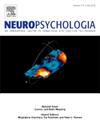操纵视觉、规则和运动冲突部分分离了多个需求皮层子区域
IF 2
3区 心理学
Q3 BEHAVIORAL SCIENCES
引用次数: 0
摘要
灵活的行为需要认知控制机制来有效地调解竞争信息和替代行为之间的冲突。是否一个全局的神经资源调解所有形式的冲突,或者这是在特定领域的系统中实现的,目前还不清楚。在全因子设计中,我们使用一种新的功能磁共振成像范式来正交地操纵规则、反应和基于刺激的冲突。全脑体素分析表明,与这些冲突类型相关的激活模式是不同的,但它们在认知任务中最常见的多需求皮层(MDC)区域内部分重叠。利益区域分析表明,大多数MDC子区域都针对所有冲突类型激活,但激活程度差别很大。我们提出,冲突解决是分布式大脑网络的一种紧急特性,其功能-解剖成分处于连续的,而不是分类的,从专业领域到一般领域的尺度上。MDC大脑区域位于该尺度的一端,但仍然表现出显著的功能异质性。本文章由计算机程序翻译,如有差异,请以英文原文为准。
Manipulating visual, rule and motor conflict partially dissociates multiple demand cortex sub-regions
Flexible behaviour requires cognitive-control mechanisms to efficiently mediate conflict between competing information and alternative actions. Whether a global neural resource mediates all forms of conflict or this is achieved within domain-specific systems remains unclear. We use a novel fMRI paradigm to orthogonally manipulate rule, response and stimulus-based conflict within a full-factorial design. Whole-brain voxelwise analyses show that activation patterns associated with these conflict types are distinct, but they partially overlap within the Multiple Demand Cortex (MDC) regions that are most commonly active during cognitive tasks. Region of interest analysis shows that most MDC sub-regions are activated for all conflict types, but to significantly varying levels. We propose that conflict resolution is an emergent property of distributed brain networks, the functional-anatomical components of which place on a continuous, not categorical, scale from domain-specialised to domain general. MDC brain regions place towards one end of that scale but still exhibit significant functional heterogeneity.
求助全文
通过发布文献求助,成功后即可免费获取论文全文。
去求助
来源期刊

Neuropsychologia
医学-行为科学
CiteScore
5.10
自引率
3.80%
发文量
228
审稿时长
4 months
期刊介绍:
Neuropsychologia is an international interdisciplinary journal devoted to experimental and theoretical contributions that advance understanding of human cognition and behavior from a neuroscience perspective. The journal will consider for publication studies that link brain function with cognitive processes, including attention and awareness, action and motor control, executive functions and cognitive control, memory, language, and emotion and social cognition.
 求助内容:
求助内容: 应助结果提醒方式:
应助结果提醒方式:


